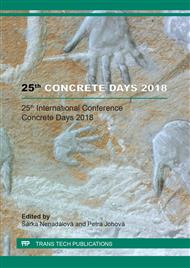p.159
p.164
p.173
p.183
p.191
p.197
p.203
p.210
p.217
Nonlinear FEM Analysis of Experimentally Tested Flat Slabs with Openings
Abstract:
Experimental programs focused on the issues related to the flat slabs still attract the attention of the scientists around the world. At the Central Laboratories of STU in Bratislava, together 8 fragments of the flat slabs were tested, focusing on the influence of the openings on the punching resistance. The two reference specimens were without openings and the others had two symmetrically placed openings. The openings were moved from the face of the column in multiples of the effective depth (0d, 1d, 2d). For the assessment of the tests, the models introduced in the relevant standards and codes were applied. The experimental results were also used for NFEM model calibration. The paper will deal with comparison of the theoretical and experimental results as well as with non-linear analysis that was performed in the ATENA FEM program, with the goal to obtain the most realistic behaviour of the flat slabs with openings. The material properties used in the analysis were obtained from the laboratory tests.
Info:
Periodical:
Pages:
191-196
Citation:
Online since:
June 2019
Authors:
Keywords:
Price:
Сopyright:
© 2019 Trans Tech Publications Ltd. All Rights Reserved
Share:
Citation:


